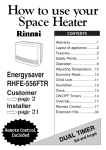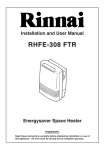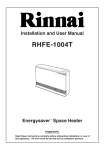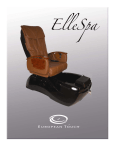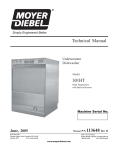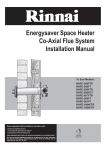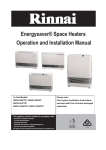Download Rinnai RHFE-556T User manual
Transcript
Installation and User Manual RHFE-556T Ñ Energysaver Space Heater Operation and Use - Page 2 Installation - Page 12 Important. Read these instructions carefully before attempting installation or use of this appliance. All work must be carried out by competent persons. CONTENTS Warranty ..........................1 Layout of appliance..........2 Features...........................4 Safety Points....................5 Operation .........................7 Adjusting Temperature .....8 Humidifier.........................9 Wiring Diagram ..............23 Gas Conversion .............24 Extension Kits ................28 Service Contact Point ....33 Rinnai Corporation - Japan ISO 9001 APPROVED BY JIA Manufactured under a Quality System Certified as complying with ISO 9001 by an Accredited Certification Body. RINNAI WARRANTY OF QUALITY As the purchaser of this high quality model RHFE-556T product you are provided with the following warranty: Heat Exchanger Fan All other parts Free Parts 15 Years 1 Year 1 Year * Full Heat Exchanger replacement (parts only) for all 15 years. This warranty does not cover cleaning and normal wear and tear, calls of this nature may be chargeable. Please check the fault finding charts on page 32, before asking for a service call. You may be able to overcome the problem without the service call, or the heater may be operating normally. Service calls to a heater which is operating normally may be chargeable, even when the heater is under warranty. The installer is responsible for your heater’s correct installation. There is no requirement to post the following information back to Rinnai UK Ltd. However we advise that you keep it in a safe place. Date of installation: Installer’s name: Address: Telephone: Licence number: CONDITIONS 1. It is a condition of this warranty that the heater shall have been serviced annually during its lifetime by a suitably qualified service engineer and that it shall have been fitted and used in accordance with the Company’s Installation and Operating instructions. 2. Failing to use genuine Rinnai spare parts may invalidate the warranty. 3. The serial number of the heater must be supplied prior to any claim being made. –1– GETTING TO KNOW YOUR NEW RHFE-556T INDICATOR PANEL CONTROL PANEL for ON-OFF And Room Temp. Control HUMIDIFIER TRAY Built into the warm air discharge duct. Humidifies the warm air flow. LOUVRE Warm air discharge duct. BOTTOM TRIM Pulls off to allow filling of humidifier tray. AIR FILTER Helps to protect the interior of the appliance and fan from dust particles. ROOM TEMPERATURE SENSOR EXHAUST OUTLET Exhausts flue products to the outside of the building. GAS CONNECTION AIR INLET TUBE Carries air for combustion. ELECTRICAL CORD FLUE SYSTEM –2– CONTROL PANEL LAYOUT ON/OFF Room temp. indicator LO 16 18 20 22 24 26 HI Room adjustment ON FILTER POWER ON / COMBUSTION INDICATOR FILTER INDICATOR Indicates that the appliance is turned ON and whether the burner is alight. Indicates that the filter needs cleaning. –3– FEATURES FORCED FLUE SYSTEM PUSH BUTTON IGNITION Air for combustion is taken from outside the room and the flue products are exhausted outside, keeping the room air clean. Only one touch of the ON/OFF switch is required to operate the heater. EXHAUST ON/OFF AIR INLET WARM AIR DISCHARGE Warm air flows from the bottom of the appliance through the louvres, assisting in even heat distribution. An integral humidifier tray is built into the warm air discharge duct. CENTRAL CONTROL This heater may be installed as part of a centrally controlled Time Clock System. In this case the heater can only be operated when the central time clock is “ON”. AUTO COMFORT Ensures that the flow of warm air from the louvres is maintained at a comfortable volume during the warm-up period by a 8 step modulating convection fan, in conjunction with the thermostat, reducing cool draughts. FILTER INDICATOR When the fan filter becomes covered with dust and the temperature inside the appliance rises, the filter indicator will flash. The filter should be vacuumed at regular intervals to avoid unnecessary strain on the appliance. FILTER INDICATOR –4– SAFETY POINTS Do not restrict the warm air discharge by placing articles in front of the heater. This appliance must not be used for any purpose other than heating. Do not spray aerosols whilst the heater is operating. Most aerosols contain butane gas, and can be a fire hazard if used near this heater when it is in use. Flue Guard must be fitted if indicated on page 17. Do not allow curtains or other flammable or combustible materials to come into contact with the heater. Do not allow anyone to sit on or lean against the appliance. Combustible materials must not be placed where the heater could ignite them. –5– SAFETY POINTS Keep flammable materials, trees, shrubs, etc, away from the flue terminal. Do not allow anyone to post articles through the louvres. GAS Gasoline LPGAS Filter should be cleaned at regular intervals. It is strongly recommended that a guard is fitted around heater where there are young children, elderly, infirm or handicapped persons. Clean with vacuum cleaner, weekly. Do not allow young children or the infirm to sleep directly in front of the heater. Do not place articles containing liquids on top of the heater. Liquids spilt on the controls may cause extensive damage. –6– OPERATING YOUR NEW RHFE-556T ■ TO OPEN THE CONTROL PANEL Open Control Panel Cover with key provided. ■ TURNING ON (For manual operation please refer to page 21). Press the ON/OFF button to operate the heater. The ON indicator will glow green. After approximately 20 seconds the spark generator will be heard before the burner ignites and the ON indicator glows red, indicating that the burner is alight. Warm air can be felt coming from the louvres 15 seconds later. If the heater does not ignite on initial use, this may be due to air remaining in the gas supply line. The spark generator will only continue for 15 seconds. After this it will be necessary to press the ON/OFF button OFF, then ON again. ■ TURNING OFF Simply press the ON/OFF button to switch off the heater. The ON indicator will go out. The convection fan will continue to operate for several minutes after the burner has gone out in order to cool the appliance. Do not unplug the appliance while the convection fan is running. IMPORTANT NOTE: DO NOT turn heater off by unplugging at the power point. The convection fan must continue to run until the appliance cools. –7– ROOM TEMPERATURE ADJUSTMENTS ON/OFF Room temp. indicator LO 16 18 20 22 24 26 HI Room adjustment ON FILTER POWER ON / COMBUSTION INDICATOR FILTER INDICATOR Indicates that the appliance is turned ON and whether the burner is alight. Indicates that the filter needs cleaning. –8– ■ FAN FILTER To protect the room air fan from dust particles or lint, a filter is situated at the rear of the appliance. When this filter becomes blocked, the filter indicator will flash to indicate that it should be cleaned. Clean the filter weekly during the heating season to avoid unnecessary strain on the appliance. Do not remove filter when appliance is operating. When the filter requires cleaning, clean filter before using the appliance, or whilst the appliance is not operating. If you do not clean the filter at regular intervals and the filter indicator is allowed to remain flashing, then the appliance will stop and [14] will flash on the Digital Display signifying that the inbuilt safety device has functioned. You must clean the filter before operating the heater again. ■ HUMIDIFIER TRAY So that you can humidify the air, your Rinnai RHFE-556T is fitted with an enamelled tray at the bottom of the heater. If you choose to make use of the humidifier tray, it will need filling about once a day during the heating season. Do not fill the humidifier tray while the heater is running. 1 To fill the humidifier tray: Remove the bottom trim panel, below the louvres, by pulling on both sides. Simply pull the tray forward to allow it to be filled with water. The warm air will be humidified as it passes over the water in the tray. Refit the bottom trim panel after filling the tray. The RHFE-556T is a very high efficiency appliance, during operation a small amount of condensation is produced in the flue system, this drains into the enamelled humidifier tray. The humidifier has the benefit (when filled with water) of raising the humidity in the air. With increased humidity, the heater can actually be run at a lower temperature while still maintaining the same level of comfort. ■ VERTICAL LOUVRE ADJUSTMENT The warm air flow direction may be altered by inserting a screwdriver or similar tool and gently bending the vertical louvre(s) either to the left or the right. Note: these louvres are not designed to be adjusted more than 6 times. –9– CARING FOR YOUR NEW RHFE-556T This appliance is safely controlled. If there is something wrong then it will stop, as it is protected by the following safety devices. Ignition Safety Device Burner Safety Device Overheat Safety Device Power Failure Safety Device Power Surge Safety Device Fan Delay Safety Device Your RHFE-556T requires very little maintenance, simply clean the rear fan filter once a week and wipe the outer case and louvre section with a damp cloth. Remote control doesn't work Takes too long to warm the room Noisy Ignition Smell of gas Combustion stops during operation Unusual combustion Cause No ON indicator Problem Burner doesn't ignite DO NOT USE SOLVENTS. Solvents may melt or distort plastic parts. Remedy Not Plugged In Plug In Power Cut Re-ignite manually after power is restored (Initial Installation) Air in gas pipe Purge air (Installer) Gas Filter Blocked Service Call Missed Ignition Service Call Flue terminal obstructed Clear obstruction Flue manifold not connected Service Call Louvre obstructed Clear obstruction Air filter blocked Clean filter (weekly) Gas Escape Service Call Gas turned off at meter Turn gas on – 10 – PRE-SERVICE CHECK Before asking for a service call please check the following points. These points are part of the normal operation of the unit. ■ At Ignition: Heater does not operate. R Is the heater plugged in? Have the fuses or breaker blown at the switch board? Is there a power failure? Is the air filter blocked? Is anything blocking the outlet for the hot air? Is the flue blocked? Is a remote timer fitted and set “ON”. Warm air does not flow when the burner lights. R The fan is started automatically after a short delay. This is to allow the heat exchanger to warm up, helping to avoid cold draughts. Smoke or strange smells are produced on the first trial light up after installation. R This is caused by grease or oil and dust on the heat exchanger and will stop after a short time. Sharp clicking noises at ignition, or when the unit cuts down on the thermostat, or goes out. R This is simply expansion noise from the heat exchanger. Clunking noise when the thermostat operates. R This is the sound of the solenoid gas valves opening and closing. Unit is not heating room. R Is the air filter blocked? Is the set temperature high enough? Is the warm air outlet blocked by anything? Are the doors and windows of the room closed? Air filter is blocked or the louvres are blocked or obstructed. R Allow heater to cool, clean air filter, operate again. Heater will not re-ignite after overheating. R Even after unit has cooled down the heater does not ignite again. Repair is necessary. Contact your local agent or Rinnai for a Service call. R This is to remove the residual heat from the heat exchanger, the fan will stop when the heater cools down. Steam is discharged from the flue terminal. R High efficiency appliances tend to discharge water vapour on cold days, this is normal. Unit cuts off without apparent reason. R Check whether filters are blocked, dirty filters will cause the heater to overheat. Power Failure. R Switch OFF, then ON again when power is restored to re-set controls. ■ During combustion: ■ When the unit is turned off: Convection fan continues to run after turning OFF. ■ Other Points: – 11 – ERROR MESAGES The Energysaver 556T has the ability to check its own operation continuously. If a fault occurs, an Error Message will flash on the Digital Display of the control panel. This assists with diagnosing the fault, and may enable you to overcome a problem without a service call. Please quote the code displayed when inquiring about service. CODE DISPLAYED FAULT REMEDY 16 Missed Ignition Check gas is turned ON. Service call if repeated. LO Flame failure Check gas is turned ON. Service call if repeated. 20 Overheat Clean filter Service call if repeated. HI Room overheat Lower room temperature to less than 40˚C. Room Temperature Sensor faulty Service call. Overheat Temperature Sensor faulty Service call. LO・16・18 Sparker failure Service call. 16・18・20 Combustion fan failure Service call. 18・20 Faulty ON/OFF switch Service call. LO・16 Faulty solenoids Service call. 26 Faulty Flame Rod Service call. 22・24・26・HI Communication Error Turn heater OFF, then ON again. 16・18・20・22・24 Flue Block Check around flue terminal 22・24 24・26 18・20・22 20・22・24 In all cases, you may be able to clear the Error Message simply by turning the heater OFF, then ON again. If the Error Message still remains or returns on the next operation contact Rinnai UK Ltd or your Supplier and arrange for a service call. – 12 – INSTALLATION INSTRUCTIONS Important Safety Instructions 1. Gas Safety (Installation & Use) Regulations 1998 are the ‘Rules in Force’. In your own interest and that of safety, it is law that all gas appliances shall be installed by competent persons in accordance with the above regulations. Failure to install appliances correctly could lead to prosecution. Other persons should NOT attempt to install this equipment. 2. Unpack the appliance and check it carefully. If it appears to have any operating defects DO NOT INSTALL, but contact the supplier. 3. This appliance is intended to be used to raise the temperature in a room or office etc. You should NOT use it for any other purpose without seeking advice from the supplier. 4. This appliance is safe if correctly installed and sited. Please comply CAREFULLY with the instructions. 5. This appliance is to be used for NATURAL GAS (G20) and PROPANE (G31) only. It must NOT be used with any other type of gas. 6. Installation MUST be carried out in accordance with the current issue of: a) Building Regulations issued by the Dept. of the Environment and Building Standards (Scotland Consolidation) Regulations. b) I.E.E. Wiring Regulations for electrical installations. c) Gas Safety (Installation and Use) Regulations 1998. d) BS5871 Part 1:2001 e) BS5440 Part 1:2000 and Part 2:2000 f) BS6891 Part 1:1998 (Natural Gas) and BS5482 Part 1:1994 (Propane). g) Local Byelaws h) Children & Young Persons Act 1933 revised 1952 i) Health and Safety at Work etc. Act, 1974 j) Such other specifications or legislation that may have superseded the above documents. 7. Should the heater be fitted in a room where there are young children; elderly; infirm or handicapped persons, it is strongly recommended that a guard is fixed around the heater. Guards conforming to British Standard Specification 6778:1986 (Fireguards for Use with Portable Free Standing or Wall Mounted Heating Appliances) in respect of fixing, strength and painted finish are acceptable and overall dimensions should be such that there is a gap of at least 100mm (4 inches) between the guard and the heater. Standard guards that meet these requirements are available from the supplier. Please be sure you are aware of the implications of these notes. – 13 – INSTALLATION INSTRUCTIONS SPECIFICATION Input: 6.4kW (21840 Btu/h) Burner: Stainless Bunsen Type Ignition: Flue: Gas Control: Electrical Supply: Continuous Spark Gas Inlet: 1/2 inch BSP Male Connection Forced Flue (Components are supplied with appliance). Rinnai Electronic Modulating Controls. 230V, 50Hz This appliance is fitted with a supply lead and 3 pin plug. ■ Remove parts from carton and check that all parts shown below are included in the installation kit. Back Spacer Set Flue Locking Clamp 1 Flue Lock Stopper 1 Insulation Clip 1 2 Hose Clip 2 1 Plastic tie for air inlet 3 1 (M4×20) 1 Wall Bracket Angle Bracket Customers operating information and Installation Instructions Air Filter 1 For Flue Lock Stopper 4 (M4) Flue Securing Screws 5 (M4) For Air Intake Clip 3 (M4) For Back Spacer Set (M4.8×32) Wood Screws Check the unit supplied is correct for the gas type in your area. Refer to local gas authority for confirmation of gas type if in doubt. Refer to data plate located on the right hand side. Check for damage, if the unit is damaged contact Rinnai. Do not install a damaged unit before checking with your supplier. Refer to an approved pipe sizing chart if in doubt about size of gas line. – 14 – 2 Wall Bracket Screws LOCATION When positioning the heater the main points governing the location are: This heater is not designed to be built in. 1. Flueing 2. Warm air distribution This heater must not be installed where curtains or other combustible materials could come into contact with it. In some cases curtains may need restraining. See diagram for other recommended clearances. 300mm The flue is not designed to be positioned under floors, or below the level of the heater. 50mm 50mm 1000mm Flue Terminal Flue Terminal The flue terminal should be positioned away from flammable materials. LP GAS Flue fittings must be kept clear of flammable materials. Flue Terminal – 15 – LOCATION Do not flue into natural draught flues or fireplaces, this unit can only be used with one of the six types of Rinnai flue kits. Do not flue unit into other rooms. Flue terminal must be outside. STANDARD INSTALLATION OF FLUE MANIFOLD. Diagram below shows minimum clearances and distances from obstructions. Also check local regulations. Flammable 600mm Wall Non Flammable 300mm 300mm 600mm When fitting the terminal beneath any ventilation opening i.e. openable window, inlet to a ventilation system etc., check that no part of the terminal will finish within 300mm when measured vertically from the bottom of such openings. When the terminal will finish less than 2m above the level of any ground to which any person has access, a terminal guard of durable material must be fitted, and these are available from your supplier. FLUE SIZES 6 Flue lengths are available. S flue suits wall 75 115 mm A flue suits wall 115 240 mm B flue suits wall 240 400 mm C flue suits wall 400 600 mm D flue suits wall 600 800 mm E flue suits wall 800 - 1000 mm 25mm spacers are available for wall thickness less than 75mm. Opposite Wall Floor Side Clearances 300mm Obstruction FIT BACK COVERS (SIDES ONLY) Fit back covers (sides only) as shown below. Engage Lugs SNOW AREAS Snow Secure with Screws In areas subject to heavy snowfall, keep snow clear of flue terminal at all times. – 16 – POSITIONING THE FLUE TERMINAL Q I Q Q P F D,E G Dimension N O C M B L N H A I H M J Terminal Position K Distance A Directly below an opening, air brick, opening windows, etc. 300mm B Above an opening, air brick, opening window, etc. 300mm C Horizontally to an opening, air brick, opening window, etc. 300mm D Below gutters, soil pipes or drain pipes. 75mm E Below eaves. 200mm F Below balconies or car port roof. 200mm G From a vertical drain pipe or soil pipe. 150mm H From an internal or external corner. 200mm I Above ground, roof or balcony level. 300mm J From a surface facing the terminal. 600mm K From a terminal facing a terminal. 1200mm L From an opening in a car port. (e.g. door, window) into a dwelling. 1200mm M Vertically from a terminal on the same wall. 1500mm N Horizontally from a terminal on the same wall. 300mm O From the wall on which the terminal is mounted N/A P From a vertical structure on the roof. N/A Q Above an intersection with roof. N/A – 17 – LOCATION Do not install the heater in an unusually dusty area. Cavity Opening R27 9 280 22 214 300 06 R2 217 φ80 Flue Hole Use a flue guard if the terminal is easily accessible to children. Check local regulations. Guards are available as an optional extra. Before drilling the flue hole, check for water and gas pipes as well as electric cables. Use an 80mm (8cm) drill for hole through wall. Guard MOUNTING TO WALL Assemble Angle Brackets to Back Spacer Top with screws provided. Locate heater in position, hold Wall Bracket in position around Angle Bracket and mark hole positions, remove heater. Secure Wall Bracket to wall. Relocate heater in position ensuring Angle Bracket engages with Wall Bracket. Floor must be level, but see page 23 regarding adjustable legs. Do not use electrical extension cords to connect unit to power supply. Keep the power cord away from the flue. FLUE MANIFOLD POSITION. FLUE EXTENSION KITS Flue extension Kits are available to allow longer flueing lengths. Contact Rinnai for information. Centre of hole for flue manifold can be drilled anywhere within the shaded area. (To avoid studs etc.) – 18 – SLEEVE AND MANIFOLD INSTALLATION METHOD FOR STANDARD WALLS 1. Dis-assemble Manifold from Sleeve. The flue consists of 3 parts, sleeve, inside connectors and tube, outside terminal; (disassemble by pulling hard on outside terminal and inner connections, then pull sleeve off outer terminal). Connections Sleeve Terminal 2. Adjustment of Sleeve Length. Measure wall thickness through previously drilled 80mm hole. End of sleeve should protrude 5-10mm from outside wall. Adjust sleeve length to wall thickness plus 5-10mm. (Sleeve is threaded for adjustment). Extension joint under plastic Extension (‘A’ and ‘S’ flues only) Adjust length by turning sleeve. 3. For A and S flues only Depending on flue set and wall thickness extension piece ‘C’ may need to be removed. Cut plastic, remove extension, then follow instruction 2. This applies to ‘A’ and ‘S’ flues only. There is no extention on other flues, they can be fully adjusted by turning the threaded section. A B C Remove extension at this point if necessary. 4. Fixing Sleeve. 5-10mm Fix to the wall, using the 3 screws provided. 2° "TOP" NOTE: The flange is marked “TOP”, sleeve must be fitted with this mark UP. Check sleeve protrudes 5-10mm on the outside. Fixing Screw Don't remove green plastic covering from sleeve. – 19 – SLEEVE AND MANIFOLD INSTALLATION METHOD FOR STANDARD WALLS 5. Check rubber seal is in place on terminal. Terminal seal 6. Installation of Terminal "TOP" mark "A" Label From outside, insert terminal into sleeve with the “A” mark at the top. Left hand side fixing tie is marked “LEFT” (from inside). Fixing Tie Terminal Cut (leave 20mm free) 7. Attaching Ties Pull hard on left and right hand side ties, clip ties over lugs inside sleeve. You should be able to pull ties 2 or 3 slots past the starting point. Cut the ties, leaving about 20 mm past the lugs. Bend ties so they are parallel with the wall. Pull hard Fixing tie Lug Sleeve 8. Insert Inner Connection Assembly. Push assembly into the terminal tube, make sure “TOP” mark is uppermost. Fix with 3 screws provided. Terminal Top Mark Screw lnner Connections 9. Manifold can still be turned after attaching. Outlet 20˚ Rubber cap Inlet – 20 – FITTING UNIT AIR INLET HOSE 2. Fit the locking clamp over connection between sliding tube and manifold. Engage the hook and rotate it until it snaps against the body of the clamp. Manifold Manifold Inlet hose Flue outlet Sliding tube Hose clip Hook Detail of Hose clip Locking clamp Locking Clamp Plastic tie 3. Fit the screw clamp between the sliding tube and the flue elbow. Secure with the 4 mm screw supplied. The flue outlet is now locked into position. Inlet elbow Flue Outlet tube screw screw clamp Inlet hose Locking clamp LOCKING CLAMP, SCREW CLAMP AND INSULATION. Flue Outlet sliding tube Flue elbow The following components can be fitted by reaching down the rear of the appliance as it is positioned against the wall. Manifold 1. Connect the flue outlet to the manifold by extending the stainless steel sliding tube until it is fully inserted into the manifold. 4. Slide the insulation sleeve up to the flue manifold, slip the securing clip over the sleeve as shown. Manifold Fit clip Sliding Tube Slide insulation sock Slide Do not extend flue tube beyond red line. Flue elbow Sock – 21 – Flue outlet Sliding tube Slide to here CONNECTING GAS AND ELECTRICAL SERVICES 1. GAS CONNECTION. Purge any air or swarf from the gas line. Connect up the appliance to the gas supply using a union service cock to facilitate servicing. Do not use hot works near the unit or the gas valve may be damaged. Inlet connection size Gas (1/2 inch BSP Male Connection) Check gas soundness using leak detection fluid, not naked flame. Connection can be easily reached from right hand side rear of appliance. Remove bottom trim (pulls off). Remove louvres (6 screws) and front panel. 2. ELECTRICAL CONNECTION. WARNING: This appliance must be earthed. This appliance is suitable for 230V - 50Hz mains only and external wiring must be carried to out I.E.E. regulations. Connect appliance to electrical supply using moulded plug supplied. A means of completely isolating the heater from the supply with contact separation of at least 3mm. on all poles must be provided for servicing. The fuse should be 3amp. Observe polarity and ensure that wiring is correctly restrained E Earth L Live N Neutral Green / Yellow Brown / Red Blue or Black IMPORTANT Do NOT use a clock or any type of switch on the electrical supply apart from the means of isolating the supply for servicing. (A clock or switch would also turn OFF the convection fan causing overheating). 3. On the rear right hand side of the heater (seen from the front) there is a terminal block with 3 numbered terminals. As delivered there is a link between terminals 2 and 3 and should be left like that where the dimension between the heater and the flue does not exceed 1.8 metres. For dimensions of more than 1.8 metres, change the link to connect between terminals 1 and 2. 4. This heater may be controlled (1) individually and manually OR (2) from a central clock. If the unit is to be controlled form a central timeclock the wiring for the clock must be done before the heater is fixed into position. 1. For simple manual control, disconnect the plug on the top of the printed circuit board and use ON / OFF switch and adjust thermostat as required. Disconnect 2. For central timer control, a transformer kit is required. See price list or contact Rinnai for advice. 3. For use in Offices or Schools etc. where all heaters are connected to a central control system which shuts down all services at the end of the working day but where individual heaters can still be set up to separate users needs, refer to Rinnai for appropriate Conversion Kit. – 22 – RINNAI 1004T/556T WIRING DIAGRAM USING RANDALL 851 PROGRAMMER RINNAI 1004T RINNAI 1004T L N L N 10:1 transformer Rinnai UK Part number 957-000-001 RINNAI 556T L N RANDALL 851 TIMER N – 23 – L GAS CONVERSION CAUTION RISK OF ELECTRIC SHOCK ❈ Disconnect electrical supply 1. Remove bottom trim (pull) 2. Remove 8 screws inside bottom louvre, pull complete front panel forward at bottom, unclip from escucheon panel and remove from heater 3. Replace small gas label on gas inlet. 4. Replace large gas label on back of appliance 5. Change very small gas label on Data Plate 6. Complete details on conversion sticker, place sticker inside left hand side panel 7. Undo main gas tube connection at manifold, 1 screw, push tube down 8. Remove “O” ring from manifold connection and refit to main gas tube (to avoid trapping “O” ring when re-assembling) 9. Remove manifold, (2 screws) take care with gasket 10. Carefully remove front damper, (1 screw) see drawing 4. 11. Using pointed nose pliers, carefully pull the right hand damper forward, and out of the burner assembly 12. Gently fit new damper-tag faces to the right 13. Refit front damper 14. Remove injectors 15. Fit new main injectors 16. Refit manifold, (slide into pin locators) then secure with screws, take care with gasket 17. Connect main gas tube, take care with “O” ring 18. Connect appliance to electricity (and gas if disconnected). 19. Follow gas pressure setting procedure, see next page. 20. Test for gas escapes 21. Replace front cover Louvre Bottom Louvre Screw Positions Drawing 1. Front Panel Louvre Drawing 2. Screw Drawing 3. Manifold HI-Limit Switch No.2 Bracket Marking Main Burner Burner Bracket Front Damper Burner Box Manifold RHS Damper Burner Box Cover Main lnjector Drawing 4. – 24 – TESTING PRESSURE CHECKING PROCEDURE: Caution- 230 V inside appliance. SW6 DIP SWITCH 1. Check that SW6 (Dip switches) are correct for the gas type for which the appliance is to be used. (Refer to diagram opposite). 2. There are two test points, one on the heat exchanger, one on the gas manifold. Connect a differential pressure gauge between both test points. (Connect one side of the gauge to one point, the other side of the gauge to the other). If you are using an electronic manometer, connect the - side to the heat exchanger test point. 3. Press the ON/OFF button to operate the appliance. 4. With the appliance operating, press SW5 once. 5. Press SW4 to operate the appliance on forced low. 6. Compare the pressure to the low pressure shown on the bottom of this page. 7. Press SW4 again. 8. Press SW3 to operate the appliance on forced high. 9. Check the pressure against the high pressure shown on the bottom of this page. 10. Press SW3 again. 11. Press SW5 again to return the heater to normal operation. 12. Turn the heater OFF, remove the pressure gauge, and replace the test point screws. 13. Reassemble appliance, set the remote clock if fitted, (see page 21) and check appliance operaton. When appliance is on check test points for gas tightness. THE REGULATOR HAS BEEN FACTORY PRE-SET. IF THE PRESSURE IS INCORRECT, CHECK THE SUPPLY PRESSURE FIRST, BEFORE MAKING ANY ADJUSTMENT TO THE APPLIANCE. ADJUSTMENT OF BURNER DIFFERENTIAL PRESSURE IS BY MEANS OF THE ROOM ADJUSTMENT BUTTONS ON THE CONTROL PANEL AND FOLLOWING THE INSTRUCTIONS GIVEN BELOW: 1. Follow checking procedure 1-6, reset the low pressure by using the “▲” or “▼” buttons on the control panel. 2. Press SW4 again to lock in the selected setting. 3. Follow checking procedure 8 and 9, reset the high pressure by using the “▲” or “▼” buttons on the control panel. 4. Press SW3 again to lock in the selected setting. 5. Press SW5 to return the heater to normal operation. 6. Turn the heater OFF, remove the pressure gauge, and replace the test point screws. 7. Reassemble appliance, set the internal and / or remote clock if fitted, and check appliance operation. When appliance is on check test points for gas tightness. – 25 – OFF ON OFF OFF NG 1 2 3 4 ON OFF OFF OFF 556T LPG 1 SW1 2 3 4 SW2 SW3 SW6 SW4 SW5 Adjusting screw Manifold Gas Valve Test point A Test point B BURNER PRESSURE SETTINGS INJECTOR SIZE NG LPG HIGH 9.2mbar 10.6mbar LOW 1.8mbar 2.0mbar 1.13 0.85 FITTING TOP SPACER + WALL CLIP ■ SECURE HEATER TO WALL Tighten all screws, fit fan filter. Fan filter Levelling screws(Adjustable legs) Fix angle bracket to back spacer with screws provided. Fix wall bracket to wall, so that the tongue of the anglebracket will fit into it, when the back spacer is fitted to the top of the heater. Up to 10 mm Adjustable Leg If necessary, the unit can be levelled using the adjustable legs under the front right and left hand side legs. ■ INSTRUCT CUSTOMER ON USE OF HEATER When you are satisfied that the appliance is operating correctly, explain operation of heater to the customer. FAULT-FAILURE PROCEDURE If unable to get the heater to operate correctly contact Rinnai. – 26 – BLOCK AND WIRING DIAGRAM WIRING DIAGRAM r w w w w INDICATOR AC 24V ON/OFF BUTTON r w w w w SW6. DIP SWITCH SW1 FM. ADJUST SWITCH〔Hi〕 TB1 SW2 FM. ADJUST SWITCH〔Lo〕 SW3 POV. PRESSURE ADJUST SWITCH〔Hi〕 bk bk SUB-P.C.B SW5. TEST SWITCH SW4 POV. PRESSURE ADJUST SWITCH〔Lo〕 J1 OPERATION P.C.B 123 r bl bl r bl bl bl bl bl bl bl bl bl w r bl 47 48 49 50 51 52 53 54 55 56 57 58 59 60 61 62 63 64 65 66 67 68 69 70 71 w TF J K OFF 1234 r OHS 〔152℃〕 I H1 H2 123 OHS No 1〔130℃〕 No 2〔90℃〕 A bk w H3 4 5 6 7 8 9 bk w 12 13 w w H w w 1, 2 SHORT: FOR EXTENSION KIT (FROM 1.8 m TO MAX LENGTH) TH y y gr/y 43 45 gy gy gy POV OHS 〈SHORT CIRCUIT PATTERN〉 2, 3 SHORT: FOR DIRECT EXHAUST OH.TH 44 46 ww TB2 FM No 3〔130℃〕 39 40 bk 41 BL W 42 F r y G bk gy r y r gr/y 23 24 25 26 34 3536 2728 29 30 y r bk gy 21 r 22 C 20 w 16 18 17 19 br bl bl w gy gy E1 SV1 W D B bk w 31 3233 y or bl 15 3A r 38 37 ER 〔F〕 E Y bk SV2 gy or AC 230V TF Y 130℃ bl MARK PART NAME MAIN SWITCH RCR REMOTE CONTROL RECEIVER RC REMOTE CONTROL TB1∼2 TERMINAL BLOCK TH THERMISTOR OH, TH OVER HEAT THERMISTOR TF THERMAL FUSE OHS1∼3 OVER HEAT SWITCH 1∼3 F FUSE FM FAN MOTOR CF CONVECTION FAN BL COMBUSTION FAN MOTOR FCC FAN CONTROL CIRCUIT SP SPARKER ER ELECTRODE FR FLAME ROD TR r SP PART NAME MS POV gr/y TR MARK MODULATING SOLENOID VALVE SV1∼2 MAIN SOLENOID VALVE 1∼2 TRANSFORMER CPU CENTRAL PROCESSING UNIT FR BLOCK DIAGRAM AC24V OH.TH 556T Hi 135° C Lo 110° C INDICATOR OH.TH TB1 MS OHS2 90° C OHS1 130° C AC230V TF 152° C OHS3 130° C CENTRAL TIMER CONTROL SUB-P.C.B TH CONTROL DISPLAY UNIT F(3A) TEMP CONTROL CIRCUIT CONTROL DISPLAY CIRCUIT CENTRAL TIMER CONTROL CIRCUIT CPU TRANSFORMER POWER SUPPLY CIRCUIT COMBUSTION FAN CIRCUIT CONVECTION FAN CIRCUIT CF FM BL FLAME ROD CIRCUIT IGNITION CIRCUIT MODULATING VALVE CIRCUIT SAFETY TIMER CIRCUIT SOLENOID VALVE CIRCUIT SP FCC FR TB2 ER MAIN BURNER GAS POV SV2 – 27 – SV1 CODE COLOUR pl purple y yellow w white gr/y green/yellow gy grey bl blue r red bk black or orange br brown gr green FORCED FLUE HEATER EXTENSION KITS EXTENSION KIT PARTS AND INSTALLATION GUIDE FOT - 155 0.5m EXTENSION KIT FOT - 156 1.0m EXTENSION KIT FOT - 157 2.0m EXTENSION KIT FOT - 158 BENT ELBOW KIT FOT - 160 LONG FLEX TUBE 600 KIT • This extension set is to be used for installations requiring extra distance. MAXIMUM FLUE LENGTH 7 METRES. Reduce length 1 metre for each bend used. (e.g. 4 metres, 3 bends). ■ NAMES AND NUMBERS OF PARTS A FOT-155(290-515mm) B FOT-156(533-1005mm) AEXHAUST PIPE DBENT ELBOW JNUT GPIPE STOPPER B KSCREW A BEXHAUST PIPE (STRAIGHT) 1 Metre EHOSE JOINT HPIPE CLAMP LSCREW B A FOT-155(750mm) B FOT-156(1250mm) C FOT-157(2000mm) L=600 CAIR INTAKE HOSE A B A B A B C C D E F G H I J K L ⑬ EXHAUST PIPE EXHAUST PIPE EXHAUST PIPE (STRAIGHT) AIR INTAKE HOSE AIR INTAKE HOSE AIR INTAKE HOSE BENT ELBOW HOSE JOINT PIPE STOPPER A PIPE STOPPER B PIPE CLAMP WALL FIXTURE NUT SCREW A SCREW B CONG FLEX TUBE FPIPE STOPPER A PARTS No. FOT 081-2 FOT 082-2 FOT 157-3 RHF 300-51-6 RHF 300-51-7 RHF 300-51-3 FOT 087-002 FOT 062-12 305F-0017 FOT 081-4 FOT 062-8 FOT 062-9 FOT 062-10 ZAA0422SC ZEAA0412SZ FOT160-2 – 28 – FOT-155 1 IWALL-FIXTURE FOT-156 FOT-157 1 1 1 ⑬LONG FLEX TUBE FOT-158 FOT-160 1 1 1 1 1 1 1 2 SET 2 2 2 4 1 1 1 3 SET 3 3 3 6 1 2 1 4 SET 4 4 4 8 1 1 1 IMPORTANT NOTE: When the appliance is installed using a flue extension that exceeds 1.8 metres you must change the link on the flue extension terminal block as shown. 3 Terminal is located at the rear of unit FOR DIRECT EXHAUST next to gas inlet. 2 USED FOR EXTENSION KITS 1 ■ TYPES COMPATIBLE WITH EXTENSION KIT RHFE - 556FTR / 556T INSTALLING AN EXTENSION KIT Installing an extension kit requires construction of an air line and the exhaust line. The air line is connected between the Air Supply Elbow at the rear of the heater and the air inlet port on the Flue pipe. Similarly, the exhaust line is connected between the joint pipe at the rear of the heater, and the exhaust port on the Flue pipe. Caution: Check to see there is no debris in pipe or hose. ■ HOW TO INSTALL MODEL: RHFE - 556FTR / 556T Example: Using 2 sets of extension kit and 1 bend kit. Example: Using 2 Metre side pipe kit. Mushroom Flue (comes with main unit) Air intake elbow (comes with main unit) Pipe stopper A Pipe stopper B Pipe clamp Pipe stopper A Bent elbow Pipe stopper B Pipe stopper A Exhaust pipe Pipe clamp Hose joint Air intake elbow (comes with main unit) Mushroom Flue (comes with main unit) Pipe stopper A Pipe stopper B Pipe clamp 1 metre straight pipe Exhaust pipe Pipe clamp Hose joint Air intake hose Pipe stopper A Pipe stopper A Pipe stopper B Hose joint Air intake hose Pipe stopper A Pipe stopper B – 29 – 1. How to connect exhaust pipes Exhaust pipe Exhaust pipe Fit inside Male end Female end Male end Pipe stopper B Pipe stopper A Female end Pipe stopper B To connect the exhaust pipes, fit the male end into the female end and clamp with pipe stopper A to prevent slipping. The exhaust pipe can be telescoped to the required length; do not cut it. Female end Male end Connect bent pipe Fit inside Pipe stopper A 2. How to connect air intake hose Air intake hose Air intake hose Hose joint Screw in counterclockwise Main unit air intake hose Air intake elbow Screw hose joint half of its length onto the air intake hose, then screw another air intake hose into the joint. The hose can be cut to the required length. IMPORTANT: The PVC air line is longer than the exhaust line and may need to be cut to size. Be sure, however, to thoroughly deburr all rough edges. 3. Affixing the air intake hose and exhaust pipe Screw A Air intake hose Wall Screw B Pipe clamp Screw A Air intake hose Exhaust pipe Wall fixture 4. How to use the bent pipe Pipe clamp Exhaust pipe Adjust the angle Wall Nut • Set the air intake hose and exhaust pipe into the pipe clamps, screw the clamp onto the wall fixture, and affix to the wall with screw B. • The air intake hose and exhaust pipe can also be screwed onto the wall using the pipe clamp and the nut. With the exhaust pipes inserted into the ends, bend the bent pipe to the angle required for installation. This part is mainly used for curves and for connection to vent terminal. – 30 – ■ CAUTIONS 1. Maximum extendable length FOR BEST ROOM AIR HUMIDITY, KEEP WATER IN THE HUMIDIFIER TRAY. 2. To prevent water condensation Condensed water may accumulate here, and cause a blockage preventing combustion. MAXIMUM FLUE LENGTH 7 METRES. Reduce length 1 metre for each bend used. (e.g. 4 metres, 3 bends). • The bend where the hose and pipes leave the body is not counted. • The air intake hose should run along the exhaust pipe. 75mm slope(approximate) Less than 2.5m 3. Condensed water formed by combustion, will run back to the unit, and may overflow from the condensation pan if pipes are longer than 2.5m. Therefore, pipes exeeding these lengths should be made to drain to the outside by giving their horizontal portions 75mm or more downward and outward slope. CAUTION Never allow the exhaust pipe to sag, as condensed water may accumulate and cause incomplete combustion. – 31 – 4. Wherever the air intake hose and exhaust pipe run sideways, try to have the exhaust pipe on top (to prevent the air intake hose from sagging onto the exhaust pipe). Exhaust pipe Exhaust pipe Air intake hose Air intake hose – 32 – DIMENSIONS 77 165 85 GAS CONNECTION WALL OPENING RANGE 06 AIR SUPPLY CONNECTION 280 134 214 300 50 554 R2 R279 280 217 36 245 632 750 SERVICE CONTACT POINT Contact: Rinnai UK Ltd. 9 Christleton Court Manor Park Runcorn WA7 1ST Tel: 01928 531870 Fax: 01928 531880 www.rinnaiuk.com – 33 – Jan 2006 556F-2190




































